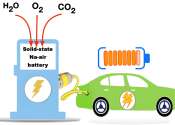New high-speed motor offers improved power density for use in electric vehicles
UNSW engineers have built a new high-speed motor which has the potential to increase the range of electric vehicles.
Sep 12, 2022
0
1571
Engineering

UNSW engineers have built a new high-speed motor which has the potential to increase the range of electric vehicles.
Sep 12, 2022
0
1571
Engineering

Motivated by the need to eliminate expensive rare-earth magnets in utility-scale direct-drive wind turbines, Sandia National Laboratories researchers developed a fundamentally new type of rotary electrical contact. Sandia ...
Sep 8, 2022
1
2280
Engineering

Imagine hopping into a zero carbon emission, personal aircraft and zipping skyward over the traffic and congestion to land conveniently right at the office.
Nov 3, 2021
1
1862
Energy & Green Tech

For over a decade, policy and industry have tried to make electric vehicles more widely available and get people to buy them. Previous research on how to do this has largely focused on examining early adopters of plug-in ...
Oct 7, 2021
7
568
Energy & Green Tech

A research team has successfully developed a high-energy, high-efficiency all-solid-state sodium-air battery. This battery can reversibly utilize sodium (Na) and air without requiring special equipment. The team was led by ...
May 28, 2024
0
93
Energy & Green Tech

As the climate crisis looms, scientists are racing to find solutions to common clean energy problems, including solar energy storage. Solar energy is one of the best renewable resources we have, but it has challenges that ...
Jun 24, 2022
4
123
Business

Last week, Tesla fired 500 employees responsible for expanding its Supercharger network.
May 8, 2024
1
44
Consumer & Gadgets

Lithium-ion batteries are the most widespread portable energy storage solution—but there are growing concerns regarding their safety.
Mar 20, 2023
0
14
Energy & Green Tech

An international team of researchers led by Stanford University have developed rechargeable batteries that can store up to six times more charge than ones that are currently commercially available.
Aug 26, 2021
3
1742
Energy & Green Tech

The governor of Indiana has announced that the Indiana Department of Transportation and Purdue University will soon begin testing the viability of "Magment"—a magnetized concrete for use in charging electric vehicles as ...
An electric vehicle (EV), also referred to as an electric drive vehicle, is a vehicle which uses one or more electric motors for propulsion. Depending on the type of vehicle, motion may be provided by wheels or propellers driven by rotary motors, or in the case of tracked vehicles, by linear motors. Electric vehicles can include electric cars, electric trains, electric airplanes, electric boats, electric motorcycles and scooters, and electric spacecraft.
Electric vehicles first came into existence in the mid-19th century, when electricity was among the preferred methods for automobile propulsion, providing a level of comfort and ease of operation that could not be achieved by the gasoline cars of the time. At one time the internal combustion engine (ICE) had completely replaced the electric drive as a propulsion method for automobiles, but electric power has remained commonplace in other vehicle types, such as trains and smaller vehicles of all types.
Electric vehicles are distinct from fossil fuel-powered vehicles in that they can receive their power from a number of sources, including fossil fuels themselves, nuclear power, and renewable sources such as tidal power, solar power, and wind power. This energy is then transmitted to the vehicle through use of overhead lines, wireless energy transfer, or a direct connection through an electrical cable. The electricity may then be stored onboard the vehicle using a battery, flywheel, supercapacitor, or fuel cell. Vehicles making use of engines working on the principle of combustion can usually only derive their energy from a single or a few sources, usually non-renewable fossil fuels.
At the beginning of the 21st century, increased concern over the environmental impact of the petroleum-based transportation infrastructure, along with the spectre of peak oil, led to renewed interest in an electric transportation infrastructure. As such, vehicles which can potentially be powered by renewable energy sources, such as hybrid electric vehicles or pure electric vehicles, are becoming more popular.
This text uses material from Wikipedia, licensed under CC BY-SA